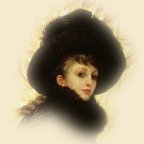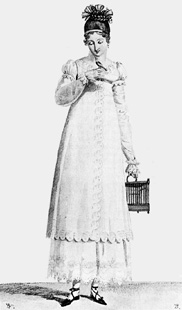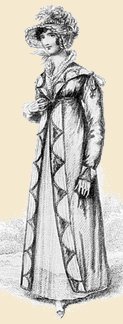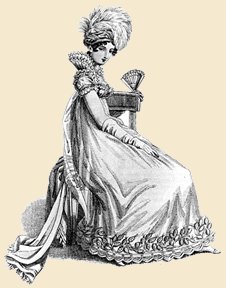



Who can read Jane Austen's Northanger Abbey without imagining the beautiful costumes the characters wear? Who can watch the movie based on Pride and Prejudice without admiring the outfits worn? I certainly can't! But my interest-level eventually changed from admiration to curiosity about the dress of that time period. I wanted to find out what specific components made up the fashionable costume. I also wanted to learn how that style came to be, considering that, just a decade before, hoop skirts and gigantic wigs were all the rage. After much reading and research, I have come up with some answers to my questions and in this article, I will share my thoughts on the subject of early 19th century dress with you!
First, what components made up a fashionable costume of the time period?
I found this out by borrowing several different historical costume books from the library and studying them all diligently. By looking at the various pictures and reading the captions and articles, I learned many things that are characteristic of the outfits of that time period. The style of clothing is now known as the Empire Style*. One characteristic of this style in ladies' clothing is the extremely high-waisted dresses. A fashionable young lady never used corsets, hoops, and numerous petticoats at the time. Wearing hoops underneath the high waist made ladies look very "interesting" and corsets were uncomfortable. Despite dropping the custom of wearing many petticoats, women still found it proper to wear a light petticoat underneath the dress. Wearing so little underneath a dress allowed the wearer to move about freely and be comfortable, but to the older generation of women, it was often considered scandalous.Once the fashion changed to high waists and no restricting undergarments, the fabric the dresses were made of changed. Muslin, crepe, silk and organdy were all considered fabrics of which to have a gown made. The fabrics were light and easy to work with and, I'm sure, were quite comfortable to wear.

Besides the standard high waist, the dresses changed in their ornament, neckline, sleeves, etc., in different years. It was, in a sense, styles within a style. For example, in 1804, when the Empire style truly "caught on," it was fashionable to wear a white underdress with trim around the neckline and a bright-colored, long-sleeved overdress that, to me, looked like a fancy housecoat. Another style for the more daring girl was a gown with puffed, short sleeves and plenty of trim. By 1807, it was popular to wear an extremely low cut, high-waisted dress, with puffed short sleeves and little or no trim decorating the skirt. Long, draping shawls made from India silk were a must, as well as long, contrasting-colored gloves. The dresses were becoming shorter by this time. It was nothing drastic - just a few inches - but wearing a dress that allowed shoes to show created another fashion change in the footwear department.
The shoes that most women wore before the shortened skirts were made from leather, a fine material for its purpose, but not very elegant. Shoes worn indoors were made from velvet, silk and other durable fabrics. Shoes made from leather were still worn when horseback riding for protection purposes.
When going out-of-doors, a short, fitted jacket that looked like a feminine version of a man's coat was popular. Also, a large-brimmed, highly-decorated bonnet was necessary when walking or riding. Women of all ages also enjoyed wearing hats and bonnets indoors, as well. One quite fashionable type of hat looked like a small, not very full, beret and was often decorated with feathers or flowers, depending on the type of dress with which it was to be worn. Another hat surprisingly resembled a "dressed-up" military helmet!
Hairstyles were another part of fashion that changed dramatically during the Empire Period. The younger women disliked the idea of wearing a hot and stuffy powdered wig to elegant events and soon took to wearing their hair as it was, with no coloring or wigs. The hairstyles that were extremely sought after resembled the styles worn by Greek and Roman women, hundreds and hundreds of years before. The hair was curled and occasionally small sections were braided. Then it was piled up into a less-than-neat bun with strings of pearls or ribbon wound through it. Short, fringe-like bangs and tendrils were also popular with young ladies of the time. Reminiscent of the recent Directoire period, some women cut their hair quite short, as short as the typical hairstyle for a man.

Up to this point, I have written mostly about the fashions for women and now I must give some insight into what a fashionable man of the period would wear. As with all men's fashions, the clothing changed gradually over time and often the outfits popular with men of the Empire period are overlooked because nothing drastic happened to the style. The outfit still consisted of the standard just-below-knee-length breeches with high, colored stockings coming to meet them. Instead of buckled shoes, riding boots were worn and tall black hats were also fashionable. A contrasting waistcoat was worn over a white shirt and a high, ruffled cravat concealed the neck up to the chin.
The most obvious change in men's fashions from that period that I have noticed is the shortening of the coat. To me, it looks as though they cut off the front of the coat, leaving just enough room for four buttons to be buttoned, and left the back as it was, creating long coat tails. The lapels of the coat increased in size and although the wearer could button the coat all the way up, it was more fashionable to leave all of the buttons unbuttoned except for the four at the bottom of the coat. A desirable accessory for men was an elaborate cane, which really had no use except to carry around.
The Empire Style and all of its changes in fashion didn't last as long as other fashion periods. Around 1818, numerous petticoats appeared once again on the fashion scene for women and, as I have mentioned before, many petticoats under a high waist gave the wearer a clumsy and bulky appearance, which was not desirable. Consequently, the waists were lowered to their natural place and corsets were worn again. At the same time, men took to wearing trousers instead of breeches and the trend stuck. Great coats took the place of the shortened coats and cravats became far simpler.
After the Empire period, it was a time for fashion revival. The mid to late nineteenth century shows no great drastic fashion change. The Empire Style was the last great mark in fashion until the 1920s.
Why did the fashion change so much in the early nineteenth century?
 In wanting to find out why the fashions changed so much during the Empire period, I looked in several history books and came up with one consistent theory. At this time period, as with many time periods, the elegant French people dictated what was considered fashionable and what wasn't. In 1804, the French Revolution had been over for 5 years, a relatively short time for those who had experienced it. One of the main issues that sparked the Revolution was the aristocrats' spending money on frippery and finery at the expense of the French people. After the Revolution, simpler, less expensive clothes were preferred, in an effort to re-unite the French people. It was like starting over, with new ideas and better plans for everyone.
In wanting to find out why the fashions changed so much during the Empire period, I looked in several history books and came up with one consistent theory. At this time period, as with many time periods, the elegant French people dictated what was considered fashionable and what wasn't. In 1804, the French Revolution had been over for 5 years, a relatively short time for those who had experienced it. One of the main issues that sparked the Revolution was the aristocrats' spending money on frippery and finery at the expense of the French people. After the Revolution, simpler, less expensive clothes were preferred, in an effort to re-unite the French people. It was like starting over, with new ideas and better plans for everyone.
The English people grasped eagerly onto the new Empire Style, for anything that was fashionable in France, was incredibly fashionable elsewhere. The English made their own adjustments to the general style and it became exceedingly popular.
I have enjoyed learning about the fashions of the Empire period so much, and I hope that you have learned something new, also! I will no longer be able to read (or watch) anything with Jane Austen's characters without knowing exactly what they wore and why. I am sure that knowing these things will make reading and watching that much more enjoyable.
(*I have often been confused as to whether Austen's stories took place during the Regency time period or the Empire time period. They do, in fact, take place during the Empire Period. Austen lived during the Regency Period.)
Reprinted with permission from the Summer 2001 issue of Inkblots Magazine.
Click here to go to a listing of Regency related links.
Illustrations for this article used with permission from Pemberley.
Artwork is October (1877) by James Tissot, courtesy of CGFA.
About
Additions
Articles
FAQ
Feature
Links
Poll
Reviews
Resources
Sewing
©2003 Across the Ages